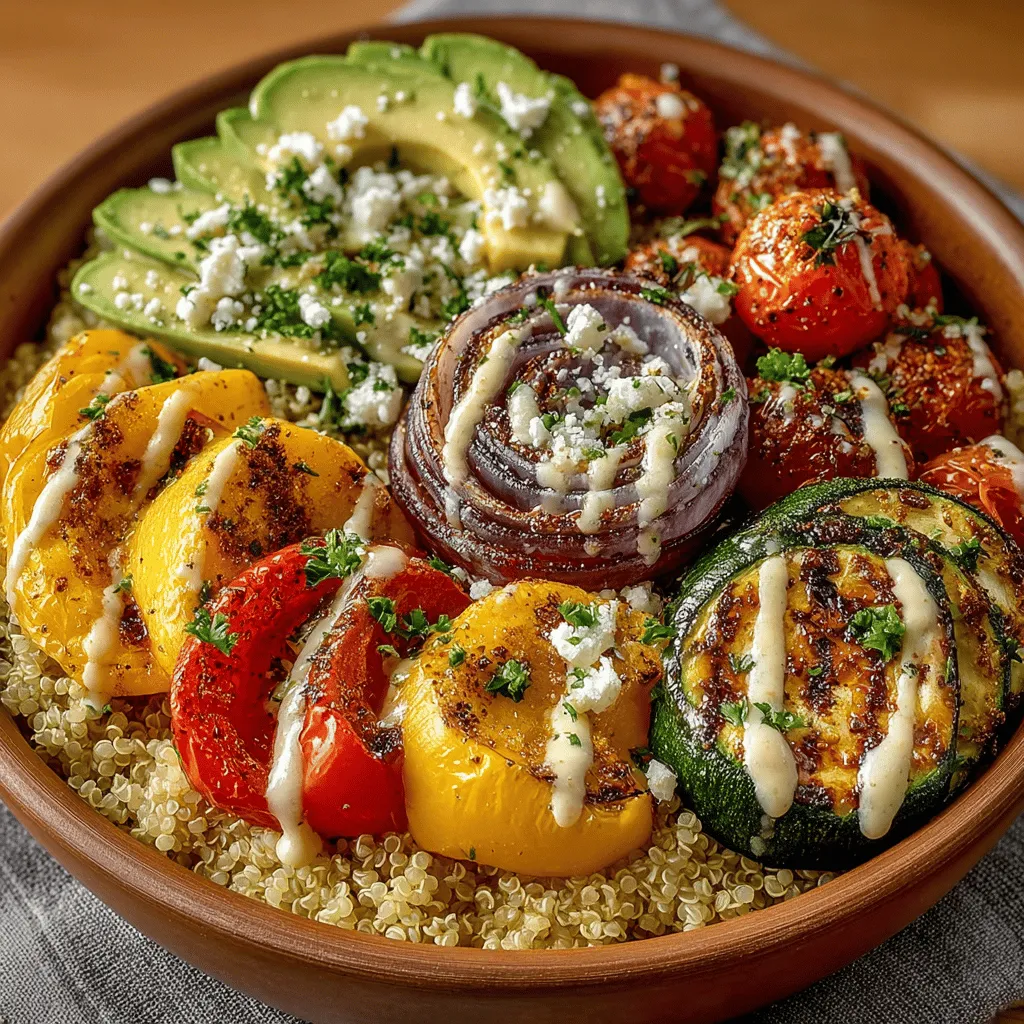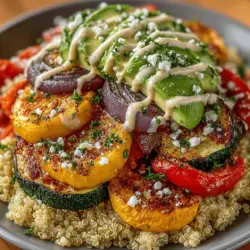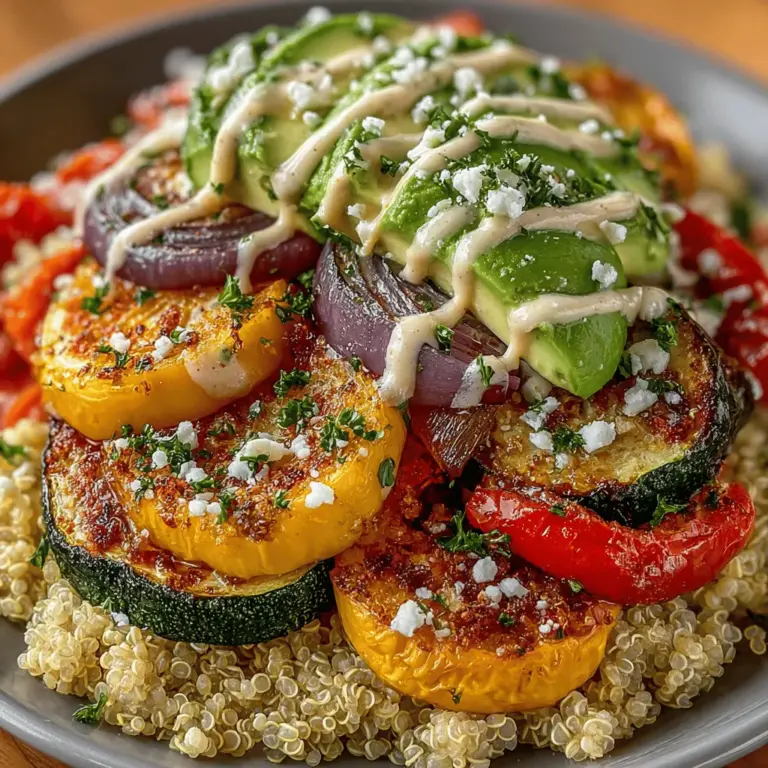Colorful Quinoa and Roasted Veggie Power Bowls: A Vibrant and Nutritious Meal Option
In today’s health-conscious world, the demand for nutritious, satisfying meals has never been higher. Enter the Colorful Quinoa and Roasted Veggie Power Bowls—a dish that perfectly balances flavor, nutrition, and visual appeal. This recipe combines the wholesome goodness of quinoa with a medley of vibrant, roasted vegetables, creating a power-packed meal that caters to a variety of dietary preferences, including vegan and gluten-free options.
Quinoa, often hailed as a superfood, serves as the foundation of this dish. Its unique nutritional profile includes high protein content, essential amino acids, and an abundance of vitamins and minerals. Coupled with a range of roasted vegetables, which are known for their rich array of antioxidants, this power bowl not only satisfies your hunger but also fuels your body with essential nutrients.
One of the most appealing aspects of this recipe is its versatility. You can customize it based on seasonal vegetables or personal preferences, making it suitable for anyone from busy professionals to families seeking a healthy meal. Whether you are a seasoned plant-based eater or simply looking to incorporate more vegetables into your diet, this power bowl will delight your taste buds and nourish your body.
Understanding the Ingredients
The Nutritional Power of Quinoa
Quinoa is not just a trendy grain; it’s a powerhouse of nutrition. Often referred to as a “complete protein,” quinoa contains all nine essential amino acids, which are crucial for muscle repair and overall health. It’s also rich in dietary fiber, making it beneficial for digestive health and promoting a feeling of fullness. Additionally, quinoa is packed with essential vitamins and minerals, including magnesium, iron, and B vitamins, which contribute to energy production and metabolic health.
This ancient grain is gluten-free, making it an ideal choice for those with gluten sensitivities or celiac disease. Its nutty flavor and fluffy texture make it a versatile base for various dishes, from salads to bowls, allowing it to shine in this colorful recipe.
The Health Benefits of Roasted Vegetables
The vegetables selected for this power bowl not only add a burst of color but also bring a wealth of health benefits. Common choices include bell peppers, zucchini, sweet potatoes, and Brussels sprouts, each offering distinct flavors and nutrients.
– Bell Peppers: High in vitamin C and antioxidants, bell peppers are known for their immune-boosting properties and ability to enhance skin health.
– Zucchini: Low in calories and high in water content, zucchini is perfect for hydration and adds a mild flavor that complements other ingredients.
– Sweet Potatoes: Rich in beta-carotene, sweet potatoes contribute to eye health and provide complex carbohydrates for sustained energy.
– Brussels Sprouts: Packed with vitamins K and C, Brussels sprouts support bone health and are high in fiber, which aids digestion.
When roasted, these vegetables undergo a transformation that enhances their natural sweetness and deepens their flavors, making them an irresistible addition to your power bowl.
Optional Toppings for Added Flavor and Nutrition
To elevate your Colorful Quinoa and Roasted Veggie Power Bowls, consider adding optional toppings that not only enhance the flavor but also boost the nutritional profile. Some fantastic options include:
– Avocado: Creamy and rich in healthy fats, avocado adds a luscious texture and helps keep you satiated.
– Nuts and Seeds: Toss in a handful of toasted almonds, walnuts, or pumpkin seeds for added crunch and a dose of healthy omega-3 fatty acids.
– Fresh Herbs: Chopped cilantro, parsley, or basil can brighten the dish and add a fresh flavor.
– Dressing: A drizzle of tahini, balsamic glaze, or a zesty lemon vinaigrette can tie all the flavors together beautifully.
Preparing the Quinoa
Now that you have a solid understanding of the ingredients, it’s time to prepare the quinoa. Properly preparing quinoa is crucial for achieving the ideal texture and flavor in your power bowl.
Step 1: Rinse the Quinoa
Start by rinsing the quinoa under cold water using a fine-mesh strainer. This step is essential because quinoa is coated with saponins—natural compounds that can impart a bitter taste if not removed. Rinsing thoroughly will wash away these saponins, resulting in a deliciously nutty flavor once cooked. It’s a quick process but one that should not be overlooked.
Step 2: Cooking the Quinoa
Once your quinoa is rinsed, it’s time to cook it. The traditional method involves using water, but for an added layer of flavor, consider cooking quinoa in vegetable broth. This will infuse the grains with a savory taste that complements the roasted vegetables beautifully.
Cooking Instructions:
1. In a medium saucepan, combine 1 cup of rinsed quinoa with 2 cups of vegetable broth (or water if you prefer).
2. Bring the mixture to a boil over medium-high heat.
3. Once boiling, reduce the heat to low, cover the pot, and let it simmer for about 15-20 minutes, or until the quinoa has absorbed all the liquid.
4. After cooking, remove the pot from heat and let it sit, covered, for an additional 5 minutes. This resting period allows the quinoa to steam and become fluffier.
Tips for Perfect Quinoa Texture
To achieve the ideal fluffy texture, avoid overcooking the quinoa. If you find that your quinoa is still too wet after absorbing the liquid, you can fluff it with a fork and let it sit uncovered for a few more minutes. This will help evaporate any excess moisture, ensuring that your quinoa is light and airy—perfect for your power bowl.
Roasting the Vegetables
With your quinoa prepared, it’s time to focus on the vegetables. Roasting is an excellent cooking method that intensifies the natural sweetness of vegetables while adding a satisfying caramelization.
Preparing the Vegetables
Start by preheating your oven to 425°F (220°C). While the oven heats, wash and chop your chosen vegetables into evenly sized pieces to ensure they roast uniformly. Aim for bite-sized chunks, which will caramelize beautifully and provide a hearty texture in your power bowl.
Seasoning Instructions:
1. In a large mixing bowl, combine the chopped vegetables with a generous drizzle of olive oil. This not only helps with roasting but also adds healthy fats.
2. Season with salt, pepper, and any additional herbs or spices you prefer—garlic powder, paprika, and thyme work particularly well with roasted vegetables.
3. Toss everything until the vegetables are well-coated with the oil and seasonings.
Optimal Roasting Temperature and Timing
Spread the seasoned vegetables in a single layer on a baking sheet lined with parchment paper. Avoid overcrowding the pan, as this can lead to steaming rather than roasting.
Roast the vegetables in the preheated oven for 20-25 minutes, stirring halfway through to ensure even cooking. You’ll know they’re done when they are tender and caramelized, with a golden-brown exterior that enhances their flavor.
Assembling the Power Bowls
After your quinoa and roasted vegetables are ready, assembling the power bowls is the final step. Layer the fluffy quinoa as the base, add a generous portion of roasted vegetables on top, and finish with your choice of toppings. This colorful presentation not only makes for an inviting meal but also showcases the nutritious ingredients that make this dish a true power bowl.
Stay tuned for the next part, where we will delve deeper into the assembly process, explore more topping options, and discuss how to customize your Colorful Quinoa and Roasted Veggie Power Bowls to suit your taste and dietary needs.

Creative Ways to Layer Ingredients for Visual Appeal and Taste
When it comes to creating the perfect power bowl, presentation is just as important as flavor. Layering your ingredients not only enhances the visual appeal but also allows for a delightful mix of textures and tastes in every bite. Start with a bed of fluffy quinoa as your base; its neutral flavor complements the vibrant roasted vegetables beautifully.
Next, consider adding a colorful array of roasted veggies—such as sweet bell peppers, zucchini, and red onions—on one side of the bowl. You can roast these vegetables with a drizzle of olive oil, salt, and pepper to enhance their natural sweetness and bring out their flavors.
On the opposite side, pile on your choice of protein—chickpeas or crumbled feta cheese work wonderfully. Chickpeas provide a hearty, plant-based protein that is both filling and nutritious, while feta offers a creamy texture that contrasts with the crunch of the veggies.
To finish the layering, add a generous handful of fresh greens like spinach or arugula on top. This not only adds a pop of color but also contributes to the nutritional value of your bowl. For an added artistic touch, consider arranging your toppings in a rainbow pattern, showcasing the beautiful array of colors to entice your guests (or just yourself!).
Suggestions for Portion Sizes
Portion sizes can vary depending on dietary needs and hunger levels, but a standard serving for a power bowl typically consists of 1 cup of cooked quinoa, 1-2 cups of roasted vegetables, and 1/2 cup of protein. For those looking to enjoy a lighter meal, you can scale down the serving sizes, while active individuals may want to increase the portions for added energy.
When preparing these bowls for meal prep, consider creating individual servings so they are ready to grab and go throughout the week. This approach not only simplifies your meal planning but also ensures that each bowl is consistently balanced and nourishing.
Ingredient Variations and Substitutions to Customize the Bowls
One of the most appealing aspects of power bowls is their versatility. You can easily customize the recipe based on personal preferences or seasonal ingredients. For a different flavor profile, try swapping out the quinoa for brown rice or farro. These grains offer unique textures and tastes, while still providing essential nutrients.
Vegetable options are nearly endless. Instead of the classic roasted veggies, consider using seasonal produce such as roasted butternut squash in the fall or asparagus in the spring. You can also experiment with different cooking methods—try grilling or steaming for a diverse flavor experience.
For protein, if you’re looking for a nut-free alternative to chickpeas, consider using edamame or cooked lentils. Each option provides a unique taste and texture while still contributing to the nutritional balance of the meal. If you enjoy adding dairy, you could also use shredded cheese or a dollop of Greek yogurt as a creamy topping.
Garnishing for Flavor and Presentation
Importance of Garnishes in Enhancing the Dish’s Aesthetic and Flavor
Garnishes play a crucial role in elevating your power bowl, both in terms of visual appeal and flavor enhancement. A thoughtfully chosen garnish can transform your dish from a simple meal to a culinary masterpiece. Fresh herbs and vibrant dressings not only add brightness but also introduce layers of flavor that complement the base ingredients.
Overview of Fresh Herbs and Dressings that Complement the Power Bowls
When it comes to herbs, consider using fresh cilantro, parsley, or basil. These herbs impart a fresh, aromatic quality that can brighten the overall flavor profile of your power bowls. For dressings, a zesty lemon-tahini sauce or a balsamic vinaigrette can provide a delightful contrast to the richness of roasted vegetables and protein.
You can easily prepare a simple dressing by whisking together olive oil, lemon juice, a touch of honey or maple syrup, and a pinch of salt. This dressing can be drizzled over the top of your power bowl for a finishing touch.
Creative Ideas for Additional Toppings that Elevate the Meal
To further elevate your power bowl, consider adding a few creative toppings. Avocado slices not only enhance the creaminess but also provide healthy fats. Toasted seeds or nuts, such as pumpkin seeds or slivered almonds, can add a satisfying crunch. For a touch of heat, sprinkle some red pepper flakes or drizzle sriracha over the top.
If you enjoy a bit of sweetness, consider adding pomegranate seeds or slices of fresh fruit like mango or apple. These toppings can provide a refreshing contrast to the savory elements of the bowl, making every bite a delightful surprise.
Nutritional Benefits of Colorful Power Bowls
Exploration of How the Combination of Ingredients Contributes to a Balanced Meal
The combination of ingredients in colorful quinoa and roasted veggie power bowls creates a well-rounded meal that is rich in vitamins, minerals, and macronutrients. Quinoa serves as an excellent source of complete protein and fiber, while the variety of vegetables contributes essential vitamins like A and C, as well as antioxidants that promote overall health.
Benefits of Plant-Based Diets and Incorporating Diverse Vegetables
Incorporating a diverse range of vegetables into your diet is a cornerstone of healthy eating. Plant-based diets have been linked to numerous health benefits, including reduced risk of chronic diseases and improved weight management. The colorful array of veggies not only ensures a wide range of nutrients but also makes your meal visually appealing, which can enhance your dining experience.
Discussion of Protein Options (Like Chickpeas and Feta) and Their Role in a Nutritious Diet
Protein is essential for maintaining muscle mass, promoting satiety, and supporting overall bodily functions. Chickpeas are a fantastic plant-based protein source, rich in fiber and essential nutrients. Feta cheese, while higher in fat, provides a rich source of calcium and can enhance the flavor profile of your power bowl. For those seeking additional protein, consider adding grilled chicken or tofu for a complete meal.
Serving Suggestions and Pairings
Ideas for Side Dishes or Beverages That Complement the Power Bowls
While the colorful quinoa and roasted veggie power bowls are deliciously satisfying on their own, you can enhance your meal with complementary side dishes or beverages. A light cucumber salad or a side of roasted sweet potato wedges can add extra flavor and texture. For drinks, consider pairing your meal with herbal iced tea or sparkling water with a splash of citrus for a refreshing finish.
Discussion of the Recipe’s Suitability for Meal Prep and Storing Leftovers
One of the best features of power bowls is their meal prep friendliness. You can roast a large batch of vegetables and cook a big pot of quinoa at the beginning of the week, portioning them out into containers for easy grab-and-go meals. The bowls can be stored in the refrigerator for up to four days, making them an excellent option for busy weekdays.
When storing leftovers, it’s best to keep the dressing separate until you’re ready to enjoy your meal. This will prevent the ingredients from becoming soggy and ensure that every bite is as fresh and flavorful as possible.
Conclusion
In conclusion, colorful quinoa and roasted veggie power bowls are not only a feast for the eyes but also a powerhouse of nutrition and flavor. With their vibrant ingredients and customizable nature, they offer a delicious way to incorporate healthy eating into your lifestyle. From the variety of vegetables and proteins to the creative garnishes and dressings, these bowls can be tailored to fit any palate.
We encourage you to experiment with this recipe and make it your own, discovering the joy of cooking with fresh, wholesome ingredients. Whether you’re trying to eat healthier, meal prepping for a busy week, or simply looking for a satisfying dish, these power bowls are an excellent choice. Embrace the versatility and health benefits they offer, and enjoy every colorful bite!


